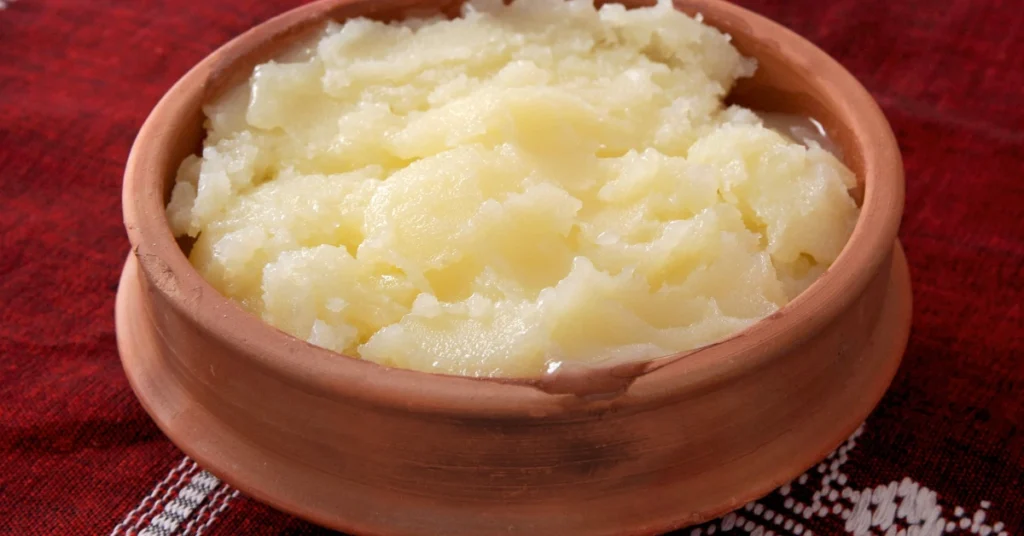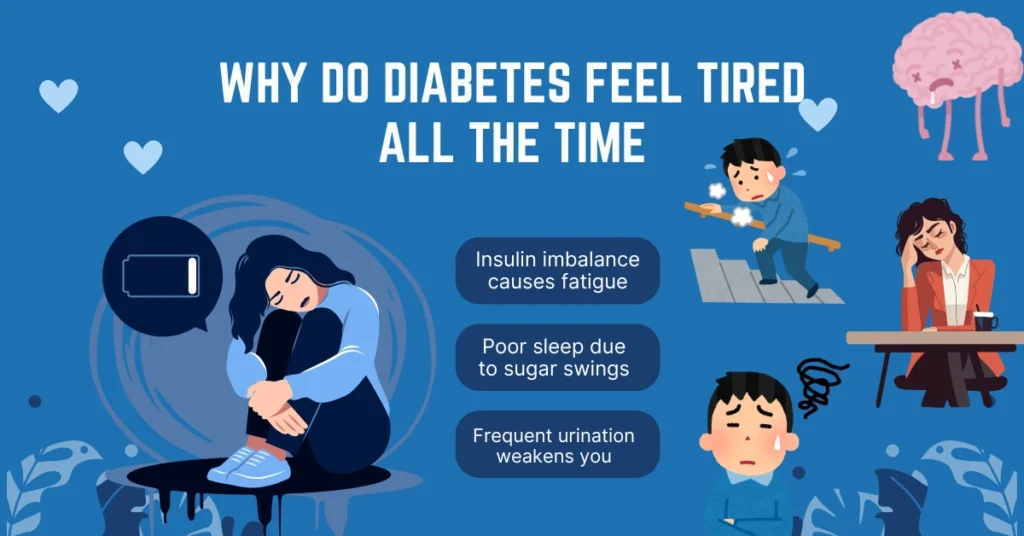Living with diabetes means making thoughtful decisions every single day, especially when it comes to food. Every bite comes with a question: Will this affect my blood sugar? Among the many items that spark confusion, ghee is right at the top.
Some praise it as a healthy fat, while others warn against it. For those managing diabetes, it’s easy to wonder whether ghee is safe or harmful.
The answer isn’t just a simple yes or no. It depends on how ghee interacts with the body, especially blood sugar levels, metabolism, and overall health. Understanding ghee’s nutritional profile and how it fits into a diabetic lifestyle can make things clearer.
So, is ghee good for diabetes? Let’s clear the confusion and understand what science and Ayurveda really say.
Nutritional Profile of Ghee
Ghee is more than just clarified butter — it’s a powerhouse of healthy fats and fat-soluble vitamins. A single teaspoon of ghee contains about 45 calories, 5 grams of fat, and zero carbohydrates, making it a unique fat source that has no direct impact on blood sugar levels.
It’s naturally rich in:
- Vitamin A, D, E, and K – essential for immunity, vision, bone health, and skin
- Omega-3 fatty acids – known to reduce inflammation
- Butyrate – a short-chain fatty acid that supports gut health and metabolism
What makes ghee special is its high smoke point and absence of lactose and casein, which makes it easier to digest compared to butter, especially for those with dairy sensitivities.
For diabetics, the absence of carbohydrates and the presence of anti-inflammatory fats can support better metabolic health, but only when consumed in moderation. It’s important to choose pure, high-quality ghee, preferably from grass-fed cows or traditional methods like bilona.
In the context of a balanced diet, ghee offers more than taste — it provides functional nutrition that may support overall well-being, even for people with diabetes.
How Ghee Affects Blood Sugar & Insulin
Ghee may be high in fat, but it doesn’t directly spike your blood sugar levels. Unlike refined oils or processed fats, ghee contains healthy saturated fats that can help balance blood sugar when used properly.
One of the key components in ghee is butyrate, a short-chain fatty acid that has shown promise in improving insulin sensitivity. Butyrate helps in reducing inflammation in the gut, which is crucial for better digestion and metabolism. This, in turn, can help with better glucose utilization by the body.
Moreover, the absence of carbohydrates in ghee means that it won’t cause a rise in blood sugar after consumption. Unlike foods that are high in simple sugars or refined carbs, ghee acts as a buffer when consumed with other meals, potentially lowering the glycemic load of those foods.
A study published in the International Journal of Obesity found that ghee’s high-fat content could help improve metabolic health by regulating blood sugar and insulin levels. This makes ghee a viable option for diabetics, especially when combined with a diet rich in whole foods and fiber.
However, moderation is key. Overconsumption of fats, even healthy ones like ghee, could lead to weight gain, which in turn may affect insulin resistance. So, while ghee can be beneficial, it’s important to include it in a well-balanced diet and not rely solely on it for blood sugar control.

Ghee in Ayurveda for Diabetes Management
In Ayurveda, ghee isn’t just seen as a fat — it’s considered a “Rasayana”, or a rejuvenating substance, that nourishes the body, strengthens immunity, and balances the doshas. Ayurveda sees ghee as a healing agent, especially in the management of chronic conditions like diabetes.
According to Ayurvedic principles, diabetes (Madhumeha) occurs due to an imbalance in the Vata and Kapha doshas, leading to poor digestion and sluggish metabolism. Ghee, when used in the right way, can help balance these doshas and support proper digestion and nutrient absorption.
Ghee also plays a key role in the absorption of herbs that are traditionally used for managing diabetes. For example, in many Ayurvedic formulations, ghee is used as a vehicle (Anupana) for herbs like Triphala, Turmeric, and Jamun, which are known for their blood sugar-lowering properties. This combination not only helps in regulating blood sugar levels but also promotes overall wellness.
Moreover, ghee is thought to improve insulin sensitivity due to its high content of butyrate and other healthy fats, which aid in fat metabolism. It also reduces inflammation in the body, a common issue for those with diabetes.
Ayurveda doesn’t advocate using ghee in excess, but when included in moderation, it can be a beneficial addition to a diabetic’s diet, enhancing both the taste and therapeutic value of meals.
How Much Ghee is Safe for Diabetics?
Let’s be real — just because something is “healthy” doesn’t mean you can go overboard. That applies to ghee too. For diabetics, portion control is everything.
The ideal amount of ghee for someone with diabetes? About 1 to 2 teaspoons per day, preferably with lunch or dinner. That’s enough to get the benefits without burdening your digestion or adding unnecessary calories.
Here’s a practical tip:
Instead of pouring ghee over your food, use it to cook your vegetables or dals. That way, you’re controlling the amount and getting the flavor without going overboard.
Also, don’t mix ghee with high-carb or sugary foods. That’s where things can go wrong. For example, ghee with white rice or refined flour might not be ideal. But ghee with whole wheat roti, millets, or sautéed vegetables? Much better choice.
And always remember: even healthy fats need balance. So if you’re already consuming nuts, seeds, or oils, adjust your ghee intake accordingly.
Think of ghee like a supporting actor in your meal — not the main hero, but definitely important for a strong performance.
Curious about how other common Indian foods affect diabetes? Check out our recent article: Is Suji Good for Diabetes?
Benefits of Ghee for Diabetics
When used in the right amount, ghee can be an ally for people managing diabetes. Here’s how:
✅ Doesn’t Spike Blood Sugar
Ghee has zero carbohydrates, so it doesn’t raise blood glucose levels. That’s a huge win for diabetics trying to control sugar swings.
✅ Improves Insulin Sensitivity
Thanks to butyrate and healthy fats, ghee may help cells respond better to insulin, improving glucose metabolism over time.
✅ Supports Digestion
A sluggish gut can mess with blood sugar, too. Ghee stimulates Agni (digestive fire) and helps with better absorption of nutrients — a key Ayurvedic principle.
✅ Reduces Inflammation
Chronic inflammation is the root cause of insulin resistance. Ghee’s omega-3s and antioxidants help calm internal inflammation.
✅Boosts Energy Without Sugar
Need energy without turning to sugary snacks? Ghee provides a slow, steady release of energy — no crashes, no cravings.
✅ Improves Nutrient Absorption
Fat-soluble vitamins like A, D, E, and K — essential for immunity and metabolism — are better absorbed when you include a little ghee in your meal.
✅ Good for Weight Management (When Used Wisely)
Unlike what people believe, a small amount of ghee can curb hunger, improve satiety, and prevent overeating.
When Ghee Might Be Harmful for Diabetics (Cautions)
Ghee can be healthy, but only when used right. For diabetics, blindly loading every meal with ghee can backfire. Here’s when you need to be careful:
⚠️ Overconsumption Can Lead to Weight Gain
Too much of anything — even good fat — adds calories. And extra weight makes insulin resistance worse. Stick to 1-2 teaspoons a day, not tablespoons.
⚠️ Pairing Ghee with High-Glycemic Foods
Adding ghee to white rice, sugary sweets, or refined carbs? Not a great combo. It may slow digestion, but it won’t cancel out the sugar spike.
⚠️ Using Poor-Quality or Processed Ghee
All ghee isn’t created equal. Store-bought versions with additives, hydrogenated fats, or artificial flavoring can do more harm than good. Always go for pure, grass-fed or bilona ghee.
⚠️ If You Already Have High Cholesterol
Ghee is rich in saturated fat. For diabetics with existing heart conditions or high cholesterol, it’s best to talk to a doctor or dietitian before including it regularly.
⚠️ Too Much Alongside Other Fats
Already cooking with oils or eating lots of nuts/seeds? Then piling on ghee might push your fat intake too high. Balance is the key.
Best Ways to Include Ghee in a Diabetic Diet
If you’re managing diabetes and want to enjoy the goodness of ghee without guilt, it’s all about how you use it. Here are some smart, balanced ways to add it to your daily meals:
🍛 Cook Veggies in Ghee
Use 1 teaspoon of ghee to lightly sauté seasonal vegetables. It enhances flavor and makes fat-soluble nutrients (like Vitamin A in carrots) easier to absorb.
🍲 Add to Dal or Khichdi (With Millets)
A few drops of ghee on hot moong dal or millet khichdi adds richness without hurting your sugar levels — especially when paired with high-fiber grains like foxtail millet or brown rice.
🫓 Use with Roti (the Right Way)
Instead of smearing a thick layer, brush a small amount of ghee on multigrain roti or jowar/bajra roti. It helps digestion and adds taste.
☕ Try Ghee in Herbal Tea or Coffee (Bulletproof Style)
This might sound unusual, but some diabetics use half a teaspoon of ghee in their herbal tea or black coffee for sustained energy — it works for some, not for all.
🍵 Mix with Herbs (Ayurvedic Style)
In Ayurveda, a small amount of ghee is often used to deliver herbs like Triphala or Turmeric. Mixing 1/2 tsp of ghee with a pinch of turmeric at night may aid inflammation and sugar control.
🔍 Pro tip: Avoid using ghee with processed, high-carb or sugary foods. Ghee is most effective when paired with whole, unrefined, fiber-rich ingredients.
Is Ghee Better Than Oil for Diabetics?
It’s a common question: Should diabetics use ghee or stick to oils like olive, sunflower, or mustard? The truth is — it’s not a one-size-fits-all answer. Both have their place. Let’s break it down:
Ghee: The Traditional Fat
- Contains butyrate, a gut-friendly fatty acid that improves insulin sensitivity.
- Stable at high heat — great for Indian cooking.
- Rich in fat-soluble vitamins (A, D, E, K).
- Has a deeper, richer flavor and supports digestion (Ayurveda-approved!).
✅ Best used in: low-to-moderate quantities with cooked veggies, dals, or rotis.
⚠️ Not ideal when: overused, or paired with high-GI or fried foods.
Refined Oils: The Modern Pick
- Many cooking oils, like sunflower or soy, are heavily processed.
- Rich in PUFAs (polyunsaturated fats) — some helpful, but not stable when heated.
- Excessive omega-6 (like in corn or soybean oil) can promote inflammation if not balanced.
✅ Best used in: cold-pressed form (like mustard or sesame oil), and in small amounts.
⚠️ Not ideal when used in deep frying or reheated multiple times.
✅ What Works Best? A Mix.
Most experts and Ayurveda both agree: don’t stick to just one fat. A combination of ghee and healthy cold-pressed oils (like mustard, coconut, or groundnut) offers both taste and nutrition, and keeps your metabolism happy.
🧠 The key is not “ghee vs. oil,” but how much and with what you use them.
Final Words: Is Ghee Good or Bad for Diabetics?
Ghee is not the villain it’s often made out to be —when used smartly and in moderation, it can be a powerful ally in managing diabetes.
It doesn’t raise blood sugar, supports digestion, reduces inflammation, and helps with insulin sensitivity — all of which are crucial for diabetics. But like anything, the benefits come only when it’s pure, portion-controlled, and paired with the right foods.
✅ So yes — ghee is good for diabetics,
❗ But only when used with awareness, not assumptions.
Swap the fear with knowledge. Don’t run away from ghee — relearn how to use it wisely. That’s what Ayurveda has always been telling us.
Can a diabetic eat ghee daily?
Yes, absolutely — but in moderation. 1 to 2 teaspoons of pure, high-quality ghee daily is generally safe and even beneficial for diabetics.
Will ghee increase my blood sugar levels?
No. Ghee contains zero carbs, so it doesn’t cause a blood sugar spike. But always pair it with healthy, low-GI foods.
What is the best time to consume ghee for diabetes?
Most people benefit from having ghee with lunch or dinner, especially when it’s part of a balanced meal (like with veggies, dals, or millet rotis).
Is homemade ghee better than store-bought for diabetics?
Yes. Homemade or bilona ghee (made from curd, not cream) is usually purer and free from additives, making it a better choice for managing diabetes.
Can I take ghee on an empty stomach in the morning?
In Ayurveda, a small amount of ghee on an empty stomach is believed to aid digestion. However, for diabetics, it’s best to consult your doctor before doing this regularly.
Final Takeaway
So, is ghee good for diabetes, or should you avoid it?
The answer lies in balance, purity, and smart usage.




